Overview
- Description
- This collection largely consists of correspondence between members of the Glattstein family and members of the Blaugrund family, who had immigrated to Mexico and then to the United States prior to the war. The wartime correspondence includes postcards from Julius and Edith Glattstein to Ladislav prior to their deportation to Auschwitz in the spring of 1944, and post-war correspondence from Ladislav and Edith Glattstein immediately post-war to their relatives discussing their wartime experiences. The collection also includes immigration documents related to the Blaugrunds and the surviving members of the Glattstein family, and digital copies of family photographs.
- Date
-
inclusive:
1910-2010
- Credit Line
- United States Holocaust Memorial Museum Collection, Gift of the family of Larry A. Gladstone, M.D.
- Collection Creator
- Larry Gladstone
- Biography
-
Ladislav Glattstein (later Larry Gladstone) was born on September 26, 1922, in Vysna Kamenica, Czechoslovakia, (now Slovakia), the only son of Julius, born 1884, and Anna Blaugrund Glattstein. He was born in the same house where his great-grandfather was born in 1828. His father’s family was Jewish Orthodox and prosperous from forestry, livestock, and farming. Julius was an innkeeper and teacher, and a World War I veteran. His only brother left for America after that war. Anna had six brothers: Joe, b. 1884, and Herman, Max, Sigmund, David, b. 1903, and Maurice, b. 1907. One brother immigrated to El Paso, Texas, in 1903. The others joined him and they operated several retail furniture stores. Ladislav had two sisters: Edith, born November 11, 1924, and Klari, born in 1929. Around 1930, they moved from their small village where they were the only Jews, to Mukacevo (now Mukacheve, Ukraine), partly for its educational opportunities. Ladislav attended a Zionist oriented school, taught all in Hebrew. His main language was Slovak, but he was fluent in German and Hungarian. His father taught religion in the public schools where it was a required subject. In 1938, Ladislav’s grandparents, Ignatz (Isaac) and Hany (Chaya) Ungar Blaugrund, left for El Paso. Ladislav’s mother Anna died in 1938 after a long illness. In September 1938, Germany annexed the Sudetenland in Czechoslovakia, and Hungary annexed the Supcarpathian Rus, which included Mukacevo.
Hungary had anti-Jewish laws similar to the Nuremberg racial laws of its close ally, Nazi Germany. By 1940, when Ladislav graduated high school, Jews could not attend university and he began tutoring in Hebrew, Latin, and math. Jewish males were not accepted into the army, but many were conscripted into forced labor battalions, which were controlled by the army. In summer 1941, Hungary joined in the German invasion of the Soviet Union. By 1943, Ladislav was in a forced labor battalion, digging ditches for communication cables and repairing bomb damaged roads at Nagybanya (Baia-Mare) labor camp. In March 1944, Germany occupied Hungary. Ladislav continued to receive frequent postcards from his father, often mailed by sympathetic German neighbor. His father told him about the invasion and that the family had been moved to a ghetto. The postcards stopped in early May 1944. Ladislav’s labor battalion was shipped to a small empty town called Dolina in southern Poland, now Ukraine. He asked a German soldier what happened to everyone and was told that they were Jews, so we shot them. Their rations were cut to starvation level: a cup of coffee, a slice of bread, watery soup. Ladislav contracted pneumonia and a Hungarian doctor put him in a military hospital where he was cured and got three meals a day. The Germans were retreating from Soviet territory and there were frequent artillery barrages as the Soviets advanced. The labor battalion was shipped back to Hungary that summer and put under the control of the German SS. They then began a death march to the Austrian border and many were beat or shot along the way. At one point, they were locked into a boxcar with no food and water for five days. Around September, they reached Balf slave labor camp. It was bitterly cold and they worked digging deep anti-tank trenches. Ladislav found a pair of felt lined, wooden shoes, which kept his feet from freezing and developing gangrene, which happened to those with leather shoes, who were then shot. Ladislav contracted louse born typhus fever and hid in a stable for many days. When he emerged, he saw American bombers flying above. In January 1945, they went on another death march to Mauthausen concentration camp in Austria where they worked in a rock quarry. Conditions were even worse There were no fields to scrounge for food and everywhere you looked, there were corpses lying on the ground. As Ladislav later testified: “If a bullet didn’t get you, the cold, filth, hunger, and disease would.” In March, he was sent on a death march to Gunskirchen, a Mauthausen subcamp concealed in the forest near Lambach. Ladislav was part of the crew digging mass graves for the hundreds of dead and soon to be dead. One day as he was digging, a Sherman tank broke through the gate and American soldiers told them they were free. This was the US Third Army and it was May 5, 1945. Ladislav asked the Americans how they found the camp and was told that they could smell it while miles away.
Ladislav went to Vienna and then to Prague in July 1945. He visited Mukachevo in August and was told by the people’s living in his family’s home that it was not his house anymore, and he should leave, or else. He enrolled in Charles University while working in a repatriation camp. Ladislav’s uncles David and Sigmund sponsored his visa application and sent money for a plane ticket from Paris to El Paso, Texas. His sister Edith, whom Ladislav thought had died at Bergen Belsen, contacted the family in Texas in October 1945. When Edith, Klari, and his father arrived at Auschwitz, she and Klari were selected for labor. His father was killed in the gas chambers. Klari got a rash a few weeks later and was sent to the gas chambers. Edith was sent in October to a slave labor camp in Schlesien. In January 1945, she was transported to Bergen Belsen and liberated in April by British forces. She spent several years recovering from tuberculosis in Sweden and came to El Paso in 1948. She later married Leo Schwartz and had three children.
Ladislav reached El Paso in June 1946. He entered the pre-medical program at the College of Mines, and attended Southwestern Medical School in 1948, specializing in internal medicine. When he became a citizen in 1952, he Americanized his name to Larry Gladstone. In 1953, Larry married Beatrice Marcus and they had three children. After serving in the Army Medical Corps, he began his successful medical career in 1958 in El Paso, and retired in 1992. Larry, 87, passed away on June 4, 2010, in El Paso.
Physical Details
- Extent
-
1 box
- System of Arrangement
- Arranged in six series: Series 1: Correspondence; Series 2: Immigration Documentation; Series 3: Biographical Information; Series 4: Photographs (only digital)
Rights & Restrictions
- Conditions on Access
- There are no known restrictions on access to this material.
- Conditions on Use
- Material(s) in this collection may be protected by copyright and/or related rights. You do not require further permission from the Museum to use this material. The user is solely responsible for making a determination as to if and how the material may be used.
Keywords & Subjects
- Topical Term
- Jews--Persecutions--Hungary. Holocaust, Jewish (1939-1945)--Ukraine--Mukacheve. Jews--Slovakia--Kos̆ice.
- Personal Name
- Gladstone, Larry.
Administrative Notes
- Holder of Originals
-
United States Holocaust Memorial Museum
- Legal Status
- Permanent Collection
- Provenance
- Larry Gladstone's family donated his collection to the United States Holocaust Memorial Museum in 2012.
- Record last modified:
- 2023-08-08 15:45:53
- This page:
- https://collections.ushmm.org/search/catalog/irn45907
Additional Resources
Download & Licensing
- In Copyright - Use Permitted
- Terms of Use
- This record is not digitized and cannot be downloaded online.
In-Person Research
- Request 7 Days in Advance of Visit
- Plan a Research Visit
-
Request in Shapell Center Reading Room
Bowie, MD
Contact Us
Also in Larry Gladstone family collection
The collection consists of three wallets, currency, scrip, correspondence, documents, and photographs relating to the experiences of Ladislav Glattstein (later Larry Gladstone) and his family before and during the Holocaust in Czechoslovakia and Hungary, and after the Holocaust in the United States.
Date: 1910-2010
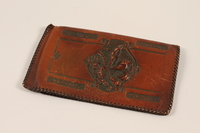
Leather wallet with an embossed floral design used by a Hungarian Jewish youth and former concentration camp inmate
Object
Embossed leather billfold that belonged to Ladislav Glattstein. Ladislav, 18, and his family lived in Munkacs, Czechoslovakia (Mukacheve, Ukraine), which was annexed by Hungary in November 1938. In 1942, Ladislav was conscripted into a Hungarian forced labor battalion. He was sent to Nagybana labor camp, and, in 1944, to the Ukraine and Balf labor camp. In January 1945, Ladislav was transported to Mauthausen concentration camp in Austria and, in March, via death march to Gunskirchen subcamp. The camp was liberated by the US Third Army on May 5, 1945. Ladislav's father Julius and his sisters, Edith and Klari, were deported to Auschwitz in May 1944; only Edith survived. Ladislav emigrated to El Paso, Texas, with the assistance of his maternal grandparents and uncles in June 1946.
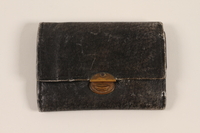
Black textured leather trifold wallet used by a Hungarian Jewish youth and former concentration camp inmate
Object
Black leather wallet with three pockets that belonged to Ladislav Glattstein. Ladislav, 18, and his family lived in Munkacs, Czechoslovakia (Mukacheve, Ukraine), which was annexed by Hungary in the fall of 1938. In 1942, Ladislav was conscripted into a Hungarian forced labor battalion. He was sent to Nagybana labor camp, and, in 1944, to the Ukraine and Balf labor camp. In January 1945, Ladislav was transported to Mauthausen concentration camp in Austria, and in March, via death march to Gunskirchen subcamp. The camp was liberated by the US Third Army on May 5, 1945. Ladislav's father Julius and his sisters, Edith and Klari, were deported to Auschwitz in May 1944; only Edith survived. Ladislav emigrated to El Paso, Texas, with the assistance of his maternal grandparents and uncles in June 1946.
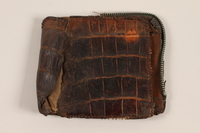
Brown alligator wallet carried by a Hungarian Jewish youth while a forced laborer and concentration camp inmate
Object
Alligator wallet with laced edges carried by Ladislav Glattstein during his forced labor service and internment in several concentration camps from 1942-1945. He received it in 1938 from an uncle who was visiting from the US. Ladislav, 18, and his family lived in Munkacs, Czechoslovakia (Mukacheve, Ukraine), which was annexed by Hungary in the fall of 1938. In 1942, Ladislav was conscripted into a Hungarian forced labor battalion. He was sent to Nagybana labor camp, and, in 1944, to the Ukraine and Balf labor camp. In January 1945, Ladislav was transported to Mauthausen concentration camp in Austria, and in March, via death march to Gunskirchen subcamp. The camp was liberated by the US Third Army on May 5, 1945. Ladislav's father Julius and his sisters, Edith and Klari, were deported to Auschwitz in May 1944; only Edith survived. Ladislav emigrated to El Paso, Texas, with the assistance of his maternal grandparents and uncles in June 1946.
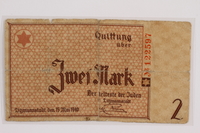
Łódź (Litzmannstadt) ghetto scrip, 2 mark note acquired by a Hungarian Jewish youth and former concentration camp inmate
Object
Łódź scrip valued at 2 marks that belonged to Ladislav Glattstein. The scrip was issued in the Jewish ghetto in Łódź, renamed Litzmannstadt by the Germans after occupying the city in September 1939. When the Germans transferred Jews to the ghetto, they confiscated all currency in exchange for Quittungen [receipts] that could be spent only inside the ghetto. The scrip was designed by the Judenrat [Jewish Council] and includes traditional Jewish symbols. Ladislav, 18, and his family lived in Munkacs, Czechoslovakia (Mukacheve, Ukraine), when it was annexed by Hungary in fall 1938. In 1942, Ladislav was conscripted into a Hungarian forced labor battalion. He was sent to Nagybana labor camp, and, in 1944, to the Ukraine and Balf labor camp. In January 1945, Ladislav was transported to Mauthausen concentration camp in Austria, and, in March, via death march to Gunskirchen subcamp. The camp was liberated by the US Third Army on May 5, 1945. Ladislav's father Julius and his sisters, Edith and Klari, were deported to Auschwitz in May 1944; only Edith survived. Ladislav emigrated to El Paso, Texas, with the assistance of his maternal grandparents and uncles in June 1946.
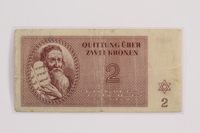
Theresienstadt ghetto-labor camp scrip, 2 kronen note acquired by a Hungarian Jewish youth and former concentration camp inmate
Object
Theresienstadt scrip valued at 2 kronen that belonged to Ladislav Glattstein. Theresienstadt was mixed use camp, primarily a transit camp and a ghetto-labor camp, in German occupied Czechoslovakia from November 1941-May 9, 1945. All currency was confiscated from camp prisoners upon entry and replaced with scrip and ration coupons that could be exchanged only in the camp. Ladislav, 18, and his family lived in Munkacs, Czechoslovakia (Mukacheve, Ukraine), when it was annexed by Hungary in fall 1938. In 1942, Ladislav was conscripted into a Hungarian forced labor battalion. He was sent to Nagybana labor camp, and, in 1944, to the Ukraine and Balf labor camp. In January 1945, Ladislav was transported to Mauthausen concentration camp in Austria, and in March, via death march to Gunskirchen subcamp. The camp was liberated by the US Third Army on May 5, 1945. Ladislav's father Julius and his sisters, Edith and Klari, were deported to Auschwitz in May 1944; only Edith survived. Ladislav emigrated to El Paso, Texas, with the assistance of his maternal grandparents and uncles in June 1946.
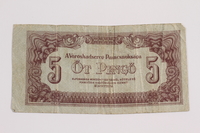
Hungarian 5 pengo paper note issued by the Soviet Army owned by a Hungarian Jewish youth and former concentration camp inmate
Object
Soviet Army occupation currency, value Öt (five) pengo, that belonged to Ladislav Glattstein. The note was issued by the Soviet Army during its occupation of Hungary in 1944. Ladislav, 18, and his family lived in Munkacs, Czechoslovakia (Mukacheve, Ukraine), when it was annexed by Hungary in fall 1938. In 1942, Ladislav was conscripted into a Hungarian forced labor battalion. He was sent to Nagybana labor camp, and, in 1944, to the Ukraine and Balf labor camp. In January 1945, Ladislav was transported to Mauthausen concentration camp in Austria, and in March, via death march to Gunskirchen subcamp which was liberated by the US Third Army on May 5, 1945. Ladislav's father Julius and his sisters, Edith and Klari, were deported to Auschwitz in May 1944; only Edith survived. Ladislav emigrated to El Paso, Texas, with the assistance of his maternal grandparents and uncles in June 1946.
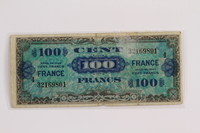
Allied Military currency for France, 100 franc bank note owned by a Hungarian Jewish concentration camp inmate
Object
Allied Military currency, 100 franc note, that belonged to Ladislav Glattstein. The currency was issued jointly by the US and Great Britain prior to the invasion of France in June 1944. Ladislav, 18, and his family lived in Munkacs, Czechoslovakia (Mukacheve, Ukraine), when it was annexed by Hungary in fall 1938. In 1942, Ladislav was conscripted into a Hungarian forced labor battalion. He was sent to Nagybana labor camp, and, in 1944, to the Ukraine and Balf labor camp. In January 1945, Ladislav was transported to Mauthausen concentration camp in Austria, and in March, via death march to Gunskirchen subcamp. The camp was liberated by the US Third Army on May 5, 1945. Ladislav's father Julius and his sisters, Edith and Klari, were deported to Auschwitz in May 1944; only Edith survived. Ladislav emigrated to El Paso, Texas, with the assistance of his maternal grandparents and uncles in June 1946.
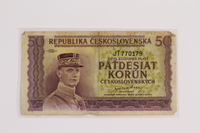
Republic of Czechoslovakia, paper currency, 50 korun note owned by a Hungarian Jewish former concentration camp inmate
Object
Fifty korun note bank note that belonged to Ladislav Glattstein. Ladislav, 18, and his family lived in Munkacs, Czechoslovakia (Mukacheve, Ukraine), when it annexed by Hungary in fall 1938. In 1942, Ladislav was conscripted into a Hungarian forced labor battalion. He was sent to Nagybana labor camp, and, in 1944, to the Ukraine and Balf labor camp. In January 1945, Ladislav was transported to Mauthausen concentration camp in Austria, and in March, via death march to Gunskirchen subcamp. The camp was liberated by the US Third Army on May 5, 1945. Ladislav's father Julius and his sisters, Edith and Klari, were deported to Auschwitz in May 1944; only Edith survived. Ladislav emigrated to El Paso, Texas, with the assistance of his maternal grandparents and uncles in June 1946.
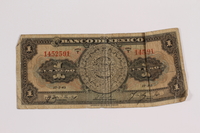
Mexico, paper currency, 1 peso owned by a Hungarian Jewish youth and former concentration camp inmate
Object
Mexican one peso bank note issued in January 1945 that belonged to Ladislav Glattstein. Ladislav, 18, and his family lived in Munkacs, Czechoslovakia (Mukacheve, Ukraine), when it was annexed by Hungary in fall 1938. In 1942, Ladislav was conscripted into a Hungarian forced labor battalion. He was sent to Nagybana labor camp, and, in 1944, to the Ukraine and Balf labor camp. In January 1945, Ladislav was transported to Mauthausen concentration camp in Austria, and in March, via death march to Gunskirchen subcamp. The camp was liberated by the US Third Army on May 5, 1945. Ladislav's father Julius and his sisters, Edith and Klari, were deported to Auschwitz in May 1944; only Edith survived. Ladislav emigrated to El Paso, Texas, with the assistance of his maternal grandparents and uncles in June 1946.
Kingdom of Hungary 20 filler coin acquired by a Hungarian Jewish youth and former concentration camp inmate
Object
Hungarian 20 filler coin dated 1941 acquired by Ladislav Glattstein presumably during the war. Ladislav, 18, and his family lived in Munkacs, Czechoslovakia (Mukacheve, Ukraine), which was annexed by Hungary in the fall of 1938. In 1942, Ladislav was conscripted into a Hungarian forced labor battalion. He was sent to Nagybana labor camp, and, in 1944, to the Ukraine and Balf labor camp. In January 1945, Ladislav was transported to Mauthausen concentration camp in Austria, and in March, via death march to Gunskirchen subcamp. The camp was liberated by the US Third Army on May 5, 1945. Ladislav's father Julius and his sisters, Edith and Klari, were deported to Auschwitz in May 1944; only Edith survived. Ladislav emigrated to El Paso, Texas, with the assistance of his maternal grandparents and uncles in June 1946.
Republic of Czechoslovakia 5 korun coin owned by a Hungarian Jewish youth and former concentration camp inmate
Object
Five korun coin owned by Ladislav Glattstein. It was issued by the prewar, independent Republic of Czechoslovakia in 1938. Ladislav, 18, and his family lived in Munkacs, Czechoslovakia (Mukacheve, Ukraine), which was annexed by Hungary in the fall of 1938. In 1942, Ladislav was conscripted into a Hungarian forced labor battalion. He was sent to Nagybana labor camp, and, in 1944, to the Ukraine and Balf labor camp. In January 1945, Ladislav was transported to Mauthausen concentration camp in Austria, and in March, via death march to Gunskirchen subcamp. The camp was liberated by the US Third Army on May 5, 1945. Ladislav's father Julius and his sisters, Edith and Klari, were deported to Auschwitz in 1944; only Edith survived. Ladislav emigrated to El Paso, Texas, with the assistance of his maternal grandparents and uncles in June 1946.
Protectorate of Bohemia and Moravia 1 koruna coin owned by a Hungarian Jewish youth and former concentration camp inmate
Object
Protectorate of Bohemia and Moravia 1 koruna coin that belonged to Ladislav Glattstein. It was issued in 1944 in the region of Czechoslovakia occupied by Nazi Germany in March 1939. Ladislav, 18, and his family lived in Munkacs, Czechoslovakia (Mukacheve, Ukraine), which was annexed by Hungary in fall 1938. In 1942, Ladislav was conscripted into a Hungarian forced labor battalion. He was sent to Nagybana labor camp, and, in 1944, to the Ukraine and Balf labor camp. In January 1945, Ladislav was transported to Mauthausen concentration camp in Austria, and in March, via death march to Gunskirchen subcamp. The camp was liberated by the US Third Army on May 5, 1945. Ladislav's father Julius and his sisters, Edith and Klari, were deported to Auschwitz in May 1944; only Edith survived. Ladislav emigrated to El Paso, Texas, with the assistance of his maternal grandparents and uncles in June 1946.
Republic of Czechoslovakia 1 korun coin owned by a Hungarian Jewish youth and former concentration camp inmate
Object
Czech 1 korun coin that belonged to Ladislav Glattstein. It was issued by the prewar, independent Republic of Czechoslovakia in 1922. Ladislav, 18, and his family lived in Munkacs, Czechoslovakia (Mukacheve, Ukraine), which was annexed by Hungary in the fall of 1938. In 1942, Ladislav was conscripted into a Hungarian forced labor battalion. He was sent to Nagybana labor camp, and, in 1944, to the Ukraine and Balf labor camp. In January 1945, Ladislav was transported to Mauthausen concentration camp in Austria, and in March, via death march to Gunskirchen subcamp. The camp was liberated by the US Third Army on May 5, 1945. Ladislav's father Julius and his sisters, Edith and Klari, were deported to Auschwitz in 1944; only Edith survived. Ladislav emigrated to El Paso, Texas, with the assistance of his maternal grandparents and uncles in June 1946.
Protectorate of Bohemia and Moravia 10 haleru coin owned by a Hungarian Jewish youth and former concentration camp inmate
Object
Protectorate of Bohemia and Moravia 10 haleru coin acquired by Ladislav Glattstein. The coin was minted in 1941 in the region of Czechoslovakia occupied by Nazi Germany on March 15, 1939. Ladislav, 18, and his family lived in Munkacs, Czechoslovakia (Mukacheve, Ukraine), when it was annexed by Hungary in the fall of 1938. In 1942, Ladislav was conscripted into a Hungarian forced labor battalion. He was sent to Nagybana labor camp, and, in 1944, to the Ukraine and Balf labor camp. In January 1945, Ladislav was transported to Mauthausen concentration camp in Austria, and in March, via death march to Gunskirchen subcamp. The camp was liberated by the US Third Army on May 5, 1945. Ladislav's father Julius and his sisters, Edith and Klari, were deported to Auschwitz in May 1944; only Edith survived. Ladislav emigrated to El Paso, Texas, with the assistance of his maternal grandparents and uncles in June 1946.



